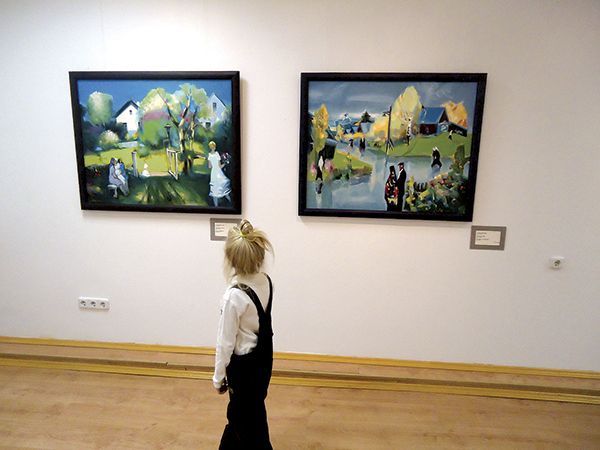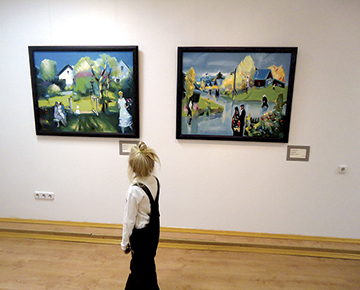Minsk Gallery named after People’s Artist of Belarus, Leonid Shchemelev, moves to city’s centre
When two young women came to his studio to suggest that he relocate the Leonid Shchemelev City Art Gallery to a more bustling district within the capital, Mr. Shchemelev was delighted. He tells us, “Why should I have any objection? If the gallery receives more visits, it will benefit everyone. I’m only glad about this.”

In the exhibition hall of Leonid Shchemelev City Gallery
The move from one of the city’s micro-districts, Serebryanka, to the central part of the capital is likely to please the famous artist’s fans. The new gallery is more accessible on public transport and has received a new look, playing with colour.
Located inside the Minsk City History Museum, which recently hosted the opening of a permanent exhibition of works by this People’s Artist of Belarus, the new gallery features 60 of his canvases from the old site (opened in 2003, following the donation of works by Mr. Shchemelev), plus canvases from the National Art Museum of Belarus.
The Opening of Painting exhibition is a retrospective of Mr. Shchemelev’s creativity, revealing his major periods and trends, as well as his genre and thematic preferences, from the 1970s to the early 2000s.
The laureate of the State Prize, cavalier of the Frantsisk Skorina Order and Great Patriotic War veteran painted large-scale historical canvases and panoramic landscapes, some of which are on show, in addition to portraits of loved ones, and philosophical and lyrical still-life works.
His individuality is always evident. As he says, “Everything I depict on my canvases is inspired by life: the history of my Homeland; memories; those I love eternally; and our landscapes, without which I couldn’t imagine living.”

The artist at his studio
Leonid Shchemelev loves to welcome guests to his studio, where he gives them a tour of his life’s work. The walls are hung densely with his pictures, from floor to ceiling and in every corner: large and smaller canvases. It’s his own gallery, which reveals the whole span of his life’s creativity. He finds his way easily in this seeming disorder, where pictures move each time I visit. He enjoys changing their position regularly.
Leonid’s mind is filled with plans and ideas. He comes to his studio every day, without fail. It’s hard to believe that he’s almost 93! He’s enjoyed dozens of personal exhibitions at home and abroad, and has participated in various international art forums. His works have been purchased by many art museums and art galleries around the globe, as well as by private collectors in Belarus, Russia, Ukraine, USA, Canada, Italy, France, Germany, Spain, Australia, Iran and Israel.
Mr. Shchemelev also holds the Union State of Belarus and Russia award. Perhaps, the jury liked the reassuringly creative manner of Mr. Shchemelev, besides his professional skills. At that time, the duo of Russian painters — the Tkachev brothers — was also awarded this prize. The Tkachev brothers were contemporaries of their Belarusian colleague, famous for reflecting past themes of labour and war time courage. Actually, they saw few topics in modern times that could inspire them for creativity.
Meanwhile, Mr. Shchemelev has been always close and clear to contemporaries, as is proven by the exposition in his gallery, where he shows us his view of the world through colours and emotions.

However, the first paintings which brought Leonid Shchemelev success were dedicated to the war. He experienced this first hand aged 20, having been on the front line for four years. It left an indelible mark on his soul, inspiring his series of paintings on his ‘war generation’. Nevertheless, today he explores other topics but explains, “War is death and human suffering. I like life, so paint on topics inspiring optimism and faith in the future — without war or turmoil.”
From the autobiography of People’s Artist of Belarus Leonid Shchemelev:
I was lucky, being born in Vitebsk — a city of artists. I spent my childhood surrounded by art lovers, albeit amateur. I learnt about colour, canvases and the smell of fresh painted pictures early on. The Dvina River was nearby, which is still sacred to me. My most treasured childhood memories are of delightful winter skiing and playing on the banks of the Dvina in summer. There were trips to my grandmother’s village and, of course, films.
The war ended all that of course. In 1941, I left, like others, to fight. In 1943, during the liberation of Belarus under Mozyr, I was seriously wounded and sent to hospital. However, I recovered sufficiently to fight again. In short, I survived those terrible war years of the last century. Destiny saved me and I went to Minsk’s Art College. Later, I worked as a teacher and, finally, I entered the Art Institute in Minsk. I was lucky again, studying under Vitaly Tsvirko — a wonderful artist and teacher, who opened my eyes to a new understanding of the world. I gradually overcame my early artistic failures and soon began to exhibit throughout Minsk, Moscow and abroad.
My artist’s life is the best gift I’ve received from God: my admiration of the world and ability to depict its surprising paradoxes. Creating art brings me great happiness.

Your teacher, Vitaly Tsvirko, disliked public speaking but his paintings were more eloquent than words. How do you categorise yourself?
I’m among those who love their profession. I can describe my thoughts in words and can critique the works of others, although I’m not a professional in this sphere. When it comes to my teacher, Vitaly Tsvirko, I have a great deal to say, as I gratefully admire him as an artist and as a person. When you’ve studied for a long time, you find that many teachers influence you. However, those who teach art can be the most influential, as they teach you so much about yourself. This allows you to grow as an artist, understanding your role and responsibilities. Mr. Tsvirko was such a teacher to me. Being a great artist, he passed on more than professional skills. He showed me humanity and love for the countryside — both of which he felt strongly himself.
Is this why pictures of nature dominate your canvases, in various states and moods?
I have few ‘pure’ landscapes as most use some pictorial construction or portray action. My characters not only complement and enliven the landscape, but are intrinsically connected to their environment. I don’t create plots but I do work on a theme, striving to reveal it to my viewer. I paint life rather than fantasy.

You travelled a lot deal across the USSR, visiting Europe and Asia. How did they influence you as an artist and for what were you searching? What did you want to understand?
I travelled a great deal, especially in Soviet times, seeing all fifteen republics. I’ve been abroad many times and always returned with vast amounts of artistic material. More importantly, I was able to compare art in each place, striving to understand what feeds the creativity of each famous artist (in the USSR and abroad). I realised the obvious: art is nurtured by folk art, culture and traditions. You can only reach the ultimate peak of success, at home or internationally, if you are true to this idea, processing that which is unique and special. In the end, you can present it to the world in a way which is universally recognisable.
So, you had the opportunity to compare sights with those of your homeland. How does Belarus differ and what do you think visitors notice most on arriving here for the first time?
Primarily, our countryside, as Belarus is covered in a whole system of pure spring lakes and a network of large and small rivers. These nourish nature, keeping colours fresh and juicy; it can’t be ignored. Colours don’t fade, they simply change with the seasons, remaining vivid. The rich green of spring and summer flowers is replaced by the amazing shades and tones of autumn. The transition is seamless and filled with majesty. Winter then takes over, with its purity and white snow. Our lace-frosted trees are like nothing else. Our countryside never looks weary. It is always alive and fresh. This may be why Belarus has always had so many wonderful landscape-painters.

Mr. Shchemelev is interesting to listen to, being sincere in his views and unafraid of speaking his mind. He always has something to say: about art, the role of the artist or the national component of art…
By Victor Mishin











